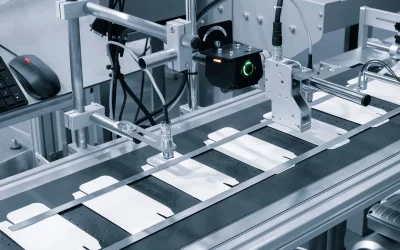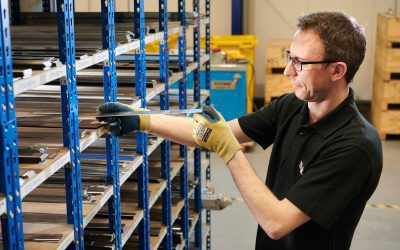The advancements in blade technology not only enhance cutting precision but also reduce waste and improve safety in meat processing facilities, underscoring their importance in the industry’s ongoing development.
This article delves into the latest innovations in meat processing blade technology, examining how these advancements are revolutionising the industry.
Innovations in Meat Processing Blade Technology
Quality of Materials
Industrial meat knives and blades are typically crafted from high-grade stainless steel, such as types 420 or 440. These materials are selected for their durability and ability to maintain sharpness over prolonged periods, which is essential in high-demand meat processing environments. The hardness of the steel ensures that the blades can endure extensive use and continue to deliver unimpeded cutting performance, crucial for maintaining operational efficiency and reducing downtime.
Advanced Coating Techniques
To further enhance the performance and longevity of meat processing blades, advanced coating techniques are employed. Coatings such as Teflon, Titanium Nitride (TiN), and Diamond-Like Carbon (DLC) are applied to the blades. These coatings not only prolong the blade’s lifespan by protecting against wear and tear but also improve the blade’s functionality. Benefits include consistent cut quality, reduced adhesive build-up on the blade, enhanced corrosion resistance, and improved release properties, which are particularly important in maintaining the speed and quality of meat processing operations.
Custom Blade Design Options
Recognising that different meat processing tasks require specific blade attributes, manufacturers offer custom blade design options to meet varied industrial needs. Whether the requirement is for bevelled, serrated, or uniquely shaped blades, companies like MRMK are equipped to design and manufacture blades that are tailored to specific operational requirements. This capability allows meat processing facilities to optimise their operations with blades that are not only highly effective but also specifically engineered to integrate seamlessly with existing machinery, thereby minimising any potential increase in downtime.
Impact of Cutting-Edge Blades on Meat Processing Efficiency
Enhanced Cutting Precision
Industrial meat knives and blades, crafted with advanced materials and coatings, significantly enhance cutting precision. This precision is crucial in maintaining consistent product sizes and shapes, which directly impacts the visual appeal and uniformity of meat products. The use of precision CNC machining in the production of these blades ensures that each cut is executed with minimal deviation, preserving the texture and quality of the meat.
Reduction in Processing Time
The integration of high-quality blades in meat processing operations notably reduces processing time. These blades are designed to handle various meat cutting tasks efficiently, from slicing and dicing to deboning and cubing. The sharpness and durability of the blades allow for continuous operation without frequent replacements or downtime for sharpening, thus maintaining a swift production line and enhancing overall throughput.
Robotic Automation in Meat Processing
Robotic automation is revolutionising the meat processing industry by enhancing precision, efficiency, and safety.
Role of Robotics in Precision Cutting
Robotic systems, equipped with advanced vision technology, are integral in the initial stages of meat production, including slaughtering and initial cutting. These robots excel in tasks requiring high precision, such as deboning and trimming, by accurately identifying bone structures and executing precise cuts. This not only reduces waste but also significantly improves yield, especially in poultry processing where speed and accuracy are paramount.
Benefits to Productivity and Safety
Adopting robotic automation offers numerous advantages over traditional manual processing. Enhanced efficiency is evident as robots can operate continuously, significantly outpacing human capabilities. The precision and consistency of robotic systems improve the quality of meat products, while advanced safety mechanisms reduce the risk of injuries associated with manual processing. Despite challenges such as the variability of raw materials and the complexity of tasks that require subtle judgement, the benefits of robotic automation in meat processing are undeniable, promising a future of increased productivity, improved safety, and higher quality products.
The Future of Meat Processing Innovations
Continued Technological Advances
The meat processing industry is poised for a transformative shift with the integration of advanced technologies like artificial intelligence (AI), machine learning (ML), and hyperspectral imaging. These innovations are set to redefine operational efficiencies by significantly reducing food waste. For instance, the PPO’s Smart Imaging System has already shown its capability to decrease food waste by up to 80% by providing early warnings before recall incidents occur. Additionally, AI’s role in tracking and analysing consumer preferences is becoming increasingly crucial, enabling quicker and more accurate market responses.
The Role of AI and Machine Learning
AI and ML are not just enhancing product quality and safety but are also pivotal in advancing food quality control through technologies such as Near-Infrared Spectroscopy (NIR). Companies like FOSS are leveraging AI with NIR to create comprehensive solutions that improve food analysis, ensuring higher standards of food safety and reducing waste. Moreover, AI-driven sensors developed by companies like AgShift and FoodLogiQ are setting new standards in real-time food monitoring, significantly mitigating risks of contamination and improving the shelf life of products. These advancements highlight the role of AI and ML in shaping the future of meat processing by enhancing transparency, efficiency, and sustainability across the supply chain.
What the future holds
While advancements in AI and machine learning are revolutionising the meat processing industry, the demand for high-quality industrial blades remains indispensable. Regardless of whether the process is executed by human hands or robotic systems, the need for precise, durable, and efficient blades is so important. These cutting-edge blades, with their advanced materials and coatings, are essential for maintaining the high standards required in meat processing operations.
Partnering with MRMK for Your Meat Processing Needs:
Choosing the right blade involves more than just selecting a sharp tool; it requires understanding the specific needs of your meat processing operations and the unique challenges posed by different meat types.
MRMK have the knowledge and understanding of your machinery to correctly identify the best industrial knife to enhance your production line, enabling you to optimise efficiency, minimise downtime, and achieve significant cost savings.
Experience the MRMK difference, where exceptional quality and customer satisfaction are our top priorities, ensuring your operations are always a cut above the rest.
Get in touch with us today and experience the MRMK difference.
Explore MRMK’s custom blade solutions now
For more machine blade buying guides, advice and information, read the MRMK News and Insights Hub…
FAQs
What are the latest advancements in meat processing technology?
The newest advancements in meat processing technology are aimed at enhancing meat quality and increasing microbial food safety. These include high pressure processing, pressure-assisted thermal sterilisation, various electrical treatments like pulsed electric fields, and thermal treatments such as ohmic heating, microwave, or radio-frequency heating.
What purposes do knives serve in food processing?
In food processing, knives and blades are essential tools for a variety of tasks. They are used for deboning, portioning, slicing, marinating, tumbling, dicing, cubing, and other cutting tasks. Additionally, packaging knives and blades are used for trimming and cutting away excess material from finished packages.
Why is it important to use knives and equipment only for their designated tasks?
It is crucial to use knives and equipment solely for their intended purposes to avoid damaging the blade and preventing injuries to yourself or others. Misusing knives for tasks like drilling holes, undoing screws, or cutting inappropriate materials can lead to damage and increase the risk of accidents.
What characteristics define a knife suitable for cutting, sectioning, and trimming raw meat?
A knife ideal for cutting, sectioning, and trimming raw meat is typically heavy, broad, and slightly curved. This design facilitates efficient handling of raw meat tasks.


 +44 (0) 1909 519815
+44 (0) 1909 519815 


